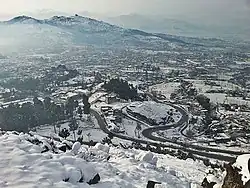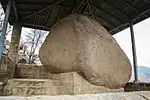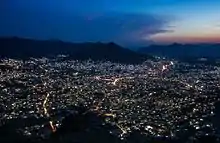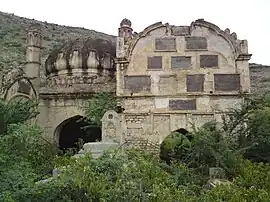Mansehra
Mansehra is a city in the Khyber Pakhtunkhwa province of Pakistan and the headquarters of Mansehra District. It is the 71st largest city of Pakistan by population and 7th largest city in the province.
Mansehra
| |
|---|---|
 Mansehra after winter snowfall | |
| Coordinates: 34°20′2″N 73°12′5″E | |
| Country | |
| Province | |
| District | Mansehra |
| Tehsil | Mansehra |
| Region | Upper Pakhli |
| Area | |
| • Total | 1,340 km2 (520 sq mi) |
| Elevation | 1,088 m (3,570 ft) |
| Population | |
| • Total | 127,623 |
| • Rank | 71st in Pakistan 7th in Khyber Pakhtunkhwa |
| • Density | 340/km2 (900/sq mi) |
| Demonym | Mansehri or Mansehrian |
| Time zone | UTC+5 (PST) |
| Postal Code | 21300 |
The name of the city is derived from name of its founder, Sardar Maha Singh Mirpuri, who was a Sikh administrator and general in the Sikh Khalsa Army during the rule of the Khalsa Empire of Maharaja Ranjit Singh.[3] The city hosts the Mansehra Shiva Temple, which is famous for its annual Shivarathri festival.[4]
History
Ancient period

With the rise of Chandragupta Maurya, the region came under the complete control of the Mauryan Empire. Ashoka governed this area as a prince, imperial throne c. 272 BCE. he made it one of the major seats of his government. The Edicts of Ashoka inscribed on three large boulders near Mansehra record fourteen of Ashoka's edicts, presenting aspects of the emperor's dharma or righteous law. These represent some of the earliest evidence of deciphered writing in the subcontinent, dating to middle of the third century BCE, and are written from right to left in the Kharosthi script.[5]
The region was briefly and nominally controlled by many foreign rulers, including the Indo-Parthians, Indo-Scythians, and Kushans, who promoted Dharmic religions throughout Central and South Asia. The region reached its height under the Buddhist ruler Kanishka the Great.
During the period,Buddhist art and architecture flourished in the area.[6]
Medieval period (500-1190 CE)
With the decline of the imperial Guptas, the Hindu Shahis came to rule the area. The Hindu Shahis built two massive forts in the northern edges of the region. The forts were later renamed as "Kafirkots" (forts of the infidel). These Hindu Shahi forts were known for high towers and steep defensive walls. The Hindus also built many Hindu temples around the area, however, much of them are now in rubble. The Hindu Shahis remained in control of the area until their defeat by the Ghaznavids in the year 1001.[6]
Modern period (1190-2000s CE)
Pakhli Sultanate (1190-1399):
This area was conquered by Sultan Pakhal Swati in 1190 who established the rule by driving out the Bambas and Ghakars rulers of this area.[7] It remained part of Sultanate of Swat also known as Pakhli Sultanate until 1399.
Pakhli Sarkar(1399-1703):
The Timiurids attacked this side of Swat Sultanate in 1370 and established their Sarkar here. The Timiurids gave Sarkar to their subjects called Hazara Turks or Karluk Turks after whom the name of Hazara Division is derived. They ruled until 1703. The last ruler was Sultan Mehmood Khurd. This Sultanate is referred as Pakhli Sarkar in Mughal documents because this area was taken from Sultan Pakhal Swati's Sultanate so the name continued on by Turks.
2nd Invasion of Swatis in 1703:
Swati's Sultanate of Swat was ended in 1519 after being defeated by Yousafzais. Swatis were finding a area to live peacefully again. In 1703, Swatis under the leadership of Syed Jalal Baba conquered Pakhli and ousted Turks. Saadaat Khan Swati was chosen as Chief of Swati tribe and the whole Pakhli was equally divided among the 3 clans of Swatis. At that time Pakhli was composed of the all areas of today's District Mansehra and District Battagram.
Pakhli State(1768-1818):
Ahmad Shah Durrani invaded the region with Timur Shah Durrani. Under Durrani Rule, the Chief of Swati tribe Saadaat Khan Swati was chosen as 1st Chief of Pakhli[8].[9] Durrani rule was interrupted by the Maratha Empire's under Raghunathrao, who drove out the Afghans,[10] Following the Third Battle of Panipat, Ahmad Shah Durrani defeated the Marathas and recaptured Lahore, Sikh forces occupied the region after the Durranis withdrew. The Durranis invaded two more times, while the Sikhs would re-occupy the region after both invasions.[9]
Sikh Rule(1818-1831)
The fall of the Durrani Empire made way for the Sikhs to rise to power under Ranjit Singh. The Sikhs gained control of the area in 1818 by defeating Habibullah Khan Swati I who was the 2nd and last ruler of Pakhli State. The town of Pakhli which is now called Mansehra was founded by Mahan Singh Mirpuri, a Sikh governor.[11][12] There were popular uprisings against Sikh rule, but these uprisings failed and the Sikhs remained in power until 1849 when the area came under British rule.[12][13][14][15]
British period
By 1849, the British had gained control of all of Mansehra. To maintain peace in the area, the British took preventive measures by co-opting the local chiefs.
Khan Jummah Khan Jehangiri Swati was the Khan of Mansehra city under British rule.[16] Atta Muhamad Khan Swati was the chief of Agror Valley, Lal Khan Sarkheli Swati was the Chief of Balakot while the hereditary Chief of Swati tribe Samundar Khan was Khan of Garhi Habibullah and Konsh Valley.[16]
The British divided Hazara region into three tehsils (administrative subdivisions): Mansehra, Abbottabad, and Haripur. In 1901, when the British formed the buffer province of North West Frontier Province (NWFP), Hazara was annexed into it.
During British rule, Mansehra was a small town. Its population according to the 1901 census was 5,087.[17] During the British period, Mansehra was the headquarters of Mansehra Tehsil.
In 1976 Mansehra Tehsil was made district and Mansehra became the centre of it.
Organisation
Mansehra City is the administrative capital of District and Tehsil Mansehra. The City of Mansehra is administratively divided into four Union Councils:[18] Mansehra City Wards No. 1–4 and Mansehra (Rural)/suburban. Each union council is divided into Mohallas.
Cultural festival
During the festival of Durgashtami, held in the first month of the Hindu calendar and the seventh month of the Nanakshahi calendar,[19] about 400 local Hindus assembled on Bareri Hill to worship Devi (as Durga). Offerings were taken by a Brahmin of Mansehra.[19] The assembly on each occasion lasted only one day.[19] The site is ancient, as at the base of Bareri Hill are the boulders inscribed with the Edicts of Ashoka.[20]
Gallery
 Northern parts of Mansehra city
Northern parts of Mansehra city The giant rock of King Ashoka.
The giant rock of King Ashoka. Sunset in Mansehra City
Sunset in Mansehra City
Khans of Mansehra
Khans also known as Nawabs of Mansehra (city only) are following :[21]
| No | Khan | Reign | Notes |
|---|---|---|---|
| 1 | Khan Sardar Khan Jahangiri Swati | 1703-1751 | Khan-E-Awal Mansehra right after the Conquest of Pakhli |
| 2 | Khan Suddam Khan Jahangiri[22] | 1751-1795(died) | 2nd Khan Of Mansehra, son of Sardar Khan |
| 3 | Khan Zaman Khan Jahangiri[23] | 1795- 1881(died) | 3rd Khan of Mansehra, Known for resistance against Sikh rule , son of Suddam Khan |
| 4 | Khan Juma Khan Jahangiri | 1881- 1910 | Son of Zaman Khan, British terminated his Khanate |
| 5 | Khan Muhammad Hussain Khan Khankhel[24] | 1910-25 | British Appointed, he was hereditary Khan of Sum |
| 6 | Khan Bahadur Raja Ali Gohar Khan Jahangiri | 1925-1958 | Restored Khanate, MLA, Governor Srinagar, Agriculture Minister Kashmir(princely state), Khan Bahadur, Raja |
| 7 | Khan Tariq Khan Jahangiri[25] | 1958-Present | Minister KPK, 3 times elected MPA of Mansehra |
Khan Muhammad Tariq Khan has been MPA of Mansehra from 1990-2002 and minister of KPK. Khan Ali Gohar Khan was the agriculture minister of Kashmir before partition, deputy commissioner, acting governor of Srinagar and MLA of West Pakistan Legislative Assembly later after partition. He was awarded the title of "Khan Bahadur" by British Viceroy and title of "Raja" by Maharaja Hari Singh of Kashmir. MPA of Mansehra, Babar Saleem Swati also belongs to the same family. He is the great grandson of 4th Khan Of Mansehra, Jummah Khan. Khurram Khan, a well known Politician of Mansehra also belongs to same family and is the great great grandson of 3rd "Khan Of Mansehra", Zaman Khan. Zaman Khan Jehangiri was well known for his resistance against Maharaja Ranjeet Singh armies in Hazara.
References
- "Mansehra Demographics table" (PDF). Pakistan Bureau of Statistics. Archived from the original (PDF) on 2018-12-27. Retrieved 2018-12-27.
- "DISTRICT AND TEHSIL LEVEL POPULATION SUMMARY WITH REGION BREAKUP (MANSEHRA DISTRICT)" (PDF). Pakistan Bureau of Statistics. 2018-01-03. Archived from the original (PDF) on 2018-04-17. Retrieved 2018-04-24.
- Hazara Report 1993, Peshawar:Govt of NWFP, p. 12
- "Pakistan prepares to hold a major Hindu festival Maha Shivaratri". Asia. Gulf News. TNN. 17 February 2020. Retrieved 22 February 2020.
- Department of Archaeology and Museums (2004-01-30). "UNESCO world heritage Centre - Mansehra Rock Edicts". Whc.unesco.org. Retrieved 2011-03-30.
- Ancient Pakistan. Chairman, Department of Archaeology, University of Peshawar. 1971.
- "Imperial Gazetteer of India Vol 19 page 319".
- "Imperial Gazetteer2 of India, Volume 19, page 319 -- Imperial Gazetteer of India -- Digital South Asia Library". dsal.uchicago.edu. Retrieved 2023-08-07.
- Edmund Bosworth, C. (26 December 2007). Historic Cities of the Islamic World. BRILL. ISBN 9789047423836.
- Roy, Kaushik (2004). India's Historic Battles: From Alexander the Great to Kargil. Permanent Black, India. pp. 80–1. ISBN 978-81-7824-109-8.
- Not to be confused with the Hindu Rajput Raja Man Singh I of Amber in Rajputana, India
- Alavi, Rehan (March 25, 2015). Beyond the Dreams Rehan Alavi. Xlibris AU. pp. 92–94. ISBN 9781503504004.
- Weekes, Colonel H. E. (December 19, 2011). History of the 5th Royal Gurkha Rifles: 1858 to 1928. Andrews UK Ltd. p. 5. ISBN 9781781493335.
- Hazara Gazetteer 1884
- Gazetteer 1884,
- "Punjab Gazetteer of Hazara District 1883-84 Page 74".
Chiefs includes Khan Samundar Khan Swati of Garhi Habibullah—the Hereditary Chief of Swati tribe, Muhammad Husain Khan Swati— The Jageerdar of Mansehra , Atta Muhamad Khan Swati— the Chief of Agror Valley.
- "Mānsehra Village - Imperial Gazetteer of India, v. 17, p. 203". Dsal.uchicago.edu. Retrieved 2011-03-30.
- "Tehsils & Unions in the District of Mansehra". Nrb.gov.pk. Archived from the original on 2011-07-18. Retrieved 2011-03-30.
- Report of the land revenue settlement of the Hazara district of the Punjab By E. G. Wace. Central Jail Press. 1876. Retrieved 2007-11-03.
In the nearby locality of Bareri, Hindus from the vicinity, to the number of about 400, used to assemble at the top of Bareri hill to worship Devi (Durga) and to present offerings, which were taken by a Brahmin of Mansehra. The assembly on each occasion lasted only one day.
- "Around Abbottabad by S.A.J. Shirazi". Travelers Digest. Archived from the original on 2007-11-10. Retrieved 2007-11-03.
Further north; go to the black mountain near Oghi or to see the Asokan inscriptions on boulders near base of Bareri Hill close to Mansehra.
- "Swati Family : Khans of Mansehra City". Swati Family. 2023-10-27. Retrieved 2023-10-26.
- "Report of the Land Revenue Settlement of the Hazara District of the Punjab, 1868-74". Google Books.
{{cite web}}: CS1 maint: url-status (link) - "Report of the Land Revenue Settlement of the Hazara District of the Punjab, 1868-74".
{{cite web}}: CS1 maint: url-status (link) - Page 74, Hazara Gazetteer. "Chief and family notes".
{{cite web}}: CS1 maint: url-status (link) - "PF-42 Mansehra Election 1993 Full Result KPK Assembly NWFP". www.electionpakistani.com. Retrieved 2023-10-26.
External links
- Mansehra Valley
- Hazara University
- Tourism Corporation of KPK
- Rural Community Council (RCC), Pakistan

.jpg.webp)

